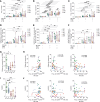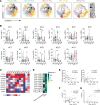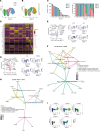NKG2C and NKG2A coexpression defines a highly functional antiviral NK population in spontaneous HIV control
- PMID: 39288262
- PMCID: PMC11529982
- DOI: 10.1172/jci.insight.182660
NKG2C and NKG2A coexpression defines a highly functional antiviral NK population in spontaneous HIV control
Abstract
Elite controllers (ECs), a unique group of people with HIV (PWH), exhibit remarkable control of viral replication in the absence of antiretroviral therapy. In this study, we comprehensively characterized the NK cell repertoire in ECs after long-term viral control. Phenotypic profiling of NK cells revealed profound differences compared with other PWH, but marked similarities to uninfected individuals, with a distinctive prevalence of NKG2C+CD57+ memory-like NK cells. Functional analyses indicated that ECs had limited production of functional molecules upon NK stimulation and consequently reduced natural cytotoxicity against non-HIV target cells. Importantly, ECs showed an exceptional ability to kill primary HIV-infected cells by the antibody-dependent cell cytotoxicity adaptive mechanism, which was achieved by a specific memory-like NK population expressing CD16, NKG2A, NKG2C, CD57, and CXCR3. In-depth single-cell RNA-seq unveiled a unique transcriptional signature in these NK cells linked to increased cell metabolism, migration, chemotaxis, effector functions, cytokine secretion, and antiviral response. Our findings underscore a pivotal role of NK cells in the immune control of HIV and identify specific NK cells as emerging targets for immunotherapies.
Keywords: AIDS/HIV; Innate immunity.
Conflict of interest statement
Figures





References
MeSH terms
Substances
LinkOut - more resources
Full Text Sources
Medical
Molecular Biology Databases

